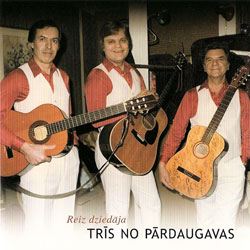
In the discography of Latvian music, one of the most glaring omissions has been the availability in digital format of American group Trīs no Pārdaugavas’ albums.
With only Circeņu kāzās—the trio’s album of songs for children—available on compact disc, it seemed as though the rest of Trīs no Pārdaugavas’ classic albums would never make it onto the digital medium. Finally, nearly two decades after the trio’s final recordings, the complete catalogue has been released on an expansive three-CD set entitled Reiz dziedāja. Having these songs on CD, rather than old scratchy and banged up vinyl records, was worth the wait.
Trīs no Pārdaugavas—made up of New Jersey area singers and guitarists Felkiss “Liksis” Ērmanis, his son Mārtiņš Ērmanis, and Vilnis Baumanis—began its work in the late 1960s. Actively performing and recording up until the early 1990s, the trio released a total of six albums and two compilations that included new songs. Mārtiņš Ērmanis died in 2000 and Felikss Ērmanis in 2004.
Reiz dziedāja gathers the albums Trīs no Pārdaugavas, Zilā jūriņā, Dienu virpulī, Mīkstās mēbelēs and No tālām robežām, as well as the new songs released on the compilations Tēvzemei and Ar rozi un ar prievīti.
The collection is a testament to Trīs no Pārdaugavas’ talent, as well as the trio’s significance in the Latvian-American community. Along with the Čikāgas piecīši, Trīs no Pārdaugavas was one of the most visible, active and beloved Latvian-American groups. The trio even gave a concert in Rīga’s Mežaparks, attracting tens of thousands of listeners.
Why was the trio so beloved? I suppose the reasons include the band’s singing and harmonies (particularly Fēlikss’ resonating voice), Baumanis’ arrangements, and the original songs (with lyrics by Baumanis) that often were about Latvian life in the United States. Or, perhaps, they were just three regular guys who came together and brightened the lives of many listeners. The music certainly is not flashy, nor does it need to be. With just three voices and three guitars (and the occasional bass guitar, percussion and piano), they were able to produce many memorable songs and melodies.
One can trace the evolution of the ensemble through this collection. The trio’s first album, the self-titled Trīs no Pārdaugavas, has a more traditional feel to it in that many of the songs were old Latvian standards, such as “Lulu,” “Lakstīgalu naktī” and “Vēstule no tāluma.” There is also a heartbreaking rendition of the Latvian folk song “Jūras māte,” where the harmonies and the transition from major to minor give the song a particularly emotional feeling.
The influence of American culture was inescapable and can be heard on the trio’s recordings. Witness the songs from Zilā jūriņā, many of which feature an almost hippie influence to them, such as the Baumanis original “Mēs gribām rokās sadoties.” There is also the melancholy “Tauta tālumā,” another Baumanis original that laments the seemingly sad fate that awaits the Latvian people, both abroad and in Latvia—at that time still well under the thumb of the Soviet government.
I like that Trīs no Pārdaugavas did not take the easy route and play well-known Latvian standards. For example, you won’t find such tired songs as “Pie dzintara jūras” or “Še kur līgo priežu meži.” Instead, the trio performed long-forgotten classics such as “Labāk glāzes pilnas liesim,” originally by the pre-World War II Latvian group Brāļi Laivinieki, as well as the tender gem “Klusi klusi ratiņš rūc.” I also like the trio’s arrangements of other songs, to the point where I think the group’s versions are superior. A personal favorite is Trīs no Pārdaugavas’ version of Raimonds Pauls’ “Kamola tinēja,” originally performed by Imants Skrastiņs in a half-sung, half-spoken manner, but now transformed into a beautifully tender song.
During the 1980s, with Baumanis at full strength as a songwriter, the trio recorded a number of classics, such as “Ratiņš” and “Kaimiņš”.
The group’s recording career closed in the early 1990s, with Latvian independence almost in reach. Songs again reflected the era—including “Šņāc un krāc,” “Pārkārtošanās” and “Latvijā – 1990,” which is about the trio’s experiences performing in Latvia in 1990.
The three CDs gather an impressive total of 70 songs. Included is a very informative booklet that has all the lyrics and also notes by Baumanis on many of the songs. Besides defining some of the Latvian-American jargon used in some of the songs—such as vīkends for weekend, pārtija for party, and kvadrātpieres for squareheads—Baumanis also clarifies some of the lyrics that may not make immediate sense to some listeners. For example, the song “Latvieši kopš seniem laikiem” mentions two Greeks, one of whom stole away with Jacqueline (a reference to shipping tycoon Aristotle Onassis) and another who drinks wine in the White House (a reference to disgraced former U.S. Vice President Spiro Agnew). If I were to find any fault with this collection, it would be that it would have been great to have even more notes from Baumanis on these songs. That would have made for some very fascinating reading.
Even though the trio played its last shows and recorded its last songs at the beginning of the 1990s, and even though two of the three members of the band are no longer with us, the group and its achievements are by no means forgotten. These timeless songs formed a significant part of the fabric of diaspora Latvian life. We are fortunate that Trīs no Pārdaugavas even existed, let alone performed and recorded. This is absolutely essential listening.
Details
Reiz dziedāja
Trīs no Pārdaugavas
EBE, 2008
© 1995-2025 Latvians Online
Please contact us for editorial queries, or for permission to republish material. Disclaimer: The content of Web sites to which Latvians Online provides links does not necessarily reflect the opinion of Latvians Online, its staff or its sponsors.





Where is this CD available for purchase?
Daini, Please contact: tnpepasts at gmail dot com for more detail.